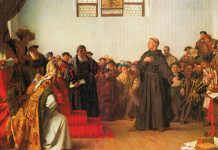Pentecostalism has its origin in the Greek word Pentecost, which means “fifty” and refers to the receiving of the Holy Spirit by the apostles on the feast of Pentecost in Jerusalem, followed by speaking in tongues (glossolalia). However, this Pentecostal phenomenon predates the Pentecostal movement which began at the beginning of the 20th century.
The very beginning of the modern Pentecostal movement has its origins in the events of the Bethel Bible School in Topeka, Kansas, opened in 1900 with 40 students by Methodist pastor Charles F. Parham. During their studies, the students concluded that the sign of the baptism with the Holy Spirit must be glossolalia. It is said that the first person in this group to experience the phenomenon of glossolalia was the young Agnes Osman,[1] who, on the night of December 31, 1900, began to speak in tongues.
Charles Parham and other students soon claimed to have had the same experience. Through the press, the “sensational” phenomenon at Parham’s school became public. Traditional churches reacted by denying the authenticity of this experience, accusing Parham of hypnotism.
In the summer of 1905, an Afro-American preacher, William J. Seymour, accepted Parham’s doctrine of the baptism of the Holy Spirit and started preaching in a building on Azusa Street, Topeka, where meetings in which men spoke and sang in different languages and prophesied continued for three years. The place on Azusa Street is generally regarded by most Pentecostals as the cradle of this movement.[2]
Most historians consider Parham and Seymour co-founders of the Pentecostal movement. Pentecostal demonstrations on Azusa Street sparked opposition from religious leaders and the media. The first issue of the magazine edited by Seymour mentioned that in several places the police made arrests among those baptized with the Holy Spirit, on the grounds that, through their manifestations, they disturbed the peace and quiet of those around them.
After the first steps in Topeka, Los Angeles, Chicago, and other cities in the United States, the Pentecostal movement spread to other continents. Unusual religious manifestations and slanderous media reports aroused increasing interest in Pentecostal gatherings. In Germany, a total of 60 evangelical leaders met in Berlin in 1907 and signed the Berlin Declaration, which called the Pentecostal movement demonic, having things in common with spiritism.[3]
The Pentecostal movement also spread to India, China, and Australia. Gradually, it penetrated deep into Christianity, despite open opposition and condemnation from the early twentieth century. This was the first wave of the Pentecostal movement, when believers organized themselves into independent churches, though different from each other. The second wave of the Pentecostal movement was the emergence and development of the charismatic movement, after 1960, through which glossolalia and other manifestations specific to Pentecostalism entered the Roman Catholic Church and various Protestant churches.
A characteristic feature of the Pentecostal movement is fragmentation. Because of this, it is difficult for a researcher to identify and study the dozens of Pentecostal branches and groups that currently exist globally.
Among the causes of such fragmentation the following can be mentioned: (a) the diverse religious background of those converted to the Pentecostal movement, sometimes generating doctrinal controversy; (b) the adoption of different organizational forms and structures: Congregational, Presbyterian, etc.; (c) accentuation of emotional feelings, which may differ from one group to another; (d) linguistic, racial differences; (e) desire for independence, originality; (f) the rivalry of leaders; (g) the explosive dynamics of the movement.
It is difficult to harmonize the groups of a movement with an unprecedented increase in the history of Christianity. The numerical growth of the Pentecostal movement has often been characterized by expressions such as “the Pentecostal miracle,” “explosive growth,” “unique phenomenon”. By the movement’s Golden Jubilee, the number of Pentecostals in the world had reached at least 10 million.
The main explanation for the growth of the Pentecostal denomination consists, in particular, in the religious beliefs and practices of the church. Ecstatic emotions and feelings play an important role in the Pentecostal movement and have attracted the curiosity and interest of a wide range of believers. The Pentecostal religious manifestations were considered by state authorities from both the interwar period and the communist period “a real danger to public health, because through the cultic exercises people reached states of nervous excitation, convulsions, articulations of sounds and meaningless syllables, causing imbalances and mental insanities to believers”.[4]
The Pentecostal doctrine of miraculous healing through prayer has also been an effective means of attraction. Another important factor in Pentecostal growth is the very high birth rate compared to other denominations. Many Pentecostal families frequently had 8-10 children. Statistics on Pentecostal pastors show that nearly two-thirds had more than four children and nearly one-third had more than seven, with 121 pastors (according to a study conducted about five decades ago) having a combined total of 572 children.[5]
While the Reformed churches sought to restore the doctrine of the early church, Pentecostalism was primarily a movement to revive the life and practice of the apostolic church. That is why Pentecostalism did not excel in institutional structures or rigorously defined organizational forms, but in the desire to revive the charisms of the early church. The emphasis was on the practice of charisma, which encouraged an exuberant atmosphere, different from the patterns of other churches. Common prayer, perseverance after the baptism of the Holy Spirit, prayers for the sick, prophecies, and speaking in tongues, dreams and visions placed the Pentecostal movement in a different register from that of the traditional churches as well as that of the neo-Protestant churches.
However, some Pentecostal authors also acknowledge a weakness—the lack of a theological system.[6] Apart from the experience of the baptism with the Holy Spirit, the Pentecostal churches did not have a well-articulated doctrine, being a movement that developed around experience and not theology. It was not until the second half of the twentieth century that Pentecostals in the West developed a theological system, but with major differences between the many branches of the movement.
Gheorghe Modoran follows and briefly explains the explosive growth of Pentecostalism and the charismatic movement that has penetrated other churches. The vulnerabilities of Pentecostalism are also assessed.



















